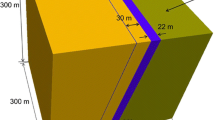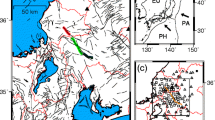Abstract
It is essential to investigate focal mechanisms of induced seismicity for understanding the rock fracturing, the failure mode, and the hazard evolution in underground mines. But the conventional methods using empiricism to infer the source mechanisms usually lead to ambiguous results for individual events. An optimized moment tensor inversion method using full waveforms was employed to quantitatively determine the rock fracturing orientation and the type of rupture process. Source parameters including the scalar moment, the moment magnitude, the full moment tensor, and the fault plane solutions were resolved of a seismic sequence in fault zones. Results show that the shear failure events in the fault F1 vicinities have similar focal mechanisms and suggest that the fault F1 is a reverse fault. The resolved strikes and dips are basically constant with the orientation of the fault. The events in the fault F2 vicinities are mainly dominated by shear-tensional failure. But the shear events experienced shear rupture and crack opening simultaneously, resulting in slippages not along the actual fault plane. There are more events in the fault F3 area which are characterized by complicated focal mechanisms. Three of the non-shear events are dominated by compressional failure and related to rock collapse, while the other non-shear events are dominated by tensional failure and related to crack opening. The shear dominated events experienced dual effects of shear failure and compression failure. The resolved fault plane solutions cannot reflect the actual geometry of the fault. It is proved that the moment tensor inversion is able to quantitatively analyze the focal mechanism of mining-induced seismicity in fault zones and it provides beneficial understandings of mining-induced fault slips.






Similar content being viewed by others
Abbreviations
- \({\text{misfit}}\) :
-
The term used to identify the difference between the synthetic data and observed data
- \({S_0}\) :
-
The term presents the source parameters configured by the \({x_0}\), \({y_0}\),\({z_0}\)
- \({\text{ST}}\) :
-
The sensor location
- \({\text{AS}}\) :
-
The amplitude spectra recorded by the sensor
- \({\text{TW}}\) :
-
The time domain waveform recorded by the sensor
- \(gf\) :
-
The Green’s functions used to calculate the synthetic data
- \(\alpha\) :
-
The resolved strike angle of the fault plane solution
- \(\beta\) :
-
The resolved dip angle of the fault plane solution
- \(\gamma\) :
-
The resolved rake angle of the fault plane solution
- \({\text{C}}{{\text{L}}_0}\) :
-
The resolved centroid location
- \({\text{C}}{{\text{T}}_{\text{0}}}\) :
-
The resolved centroid time
- \({\text{S}}{{\text{M}}_0}\) :
-
The resolved scalar seismic moment
- \({m_{ij}}\) :
-
The element of the resolved full moment tensor configurations, \(~i\) = 1, 2, 3; \(~j\) =1, 2, 3
- \({m_i}\) :
-
The eigenvalues of the moment tensor, \(i\) =1, 2, 3
- \({p_k}\) :
-
The possible polarities of the moment tensor configurations, k = 1, 2
- %ISO:
-
The percentage of the isotopic component of the moment tensor
- %DC:
-
The percentage of the double-couple component of the moment tensor
- %CLVD:
-
The percentage of the compensated linear vector dipole component of the moment tensor
References
Aki K, Richards PG (2002) Quantitative seismology. University Science Books, Sausalito
Boatwright J, Fletcher JB (1984) The partition of radiated energy between P and S waves. Bull Seismol Soc Am 74:361–376
Cesca S, Heimann S, Stammler K, Dahm T (2010) Automated procedure for point and kinematic source inversion at regional distances. J Geophys Res-Sol Ea 115(B6):3659–3667
Cesca S, Rohr A, Dahm T (2013) Discrimination of induced seismicity by full moment tensor inversion and decomposition. J Seismol 17(1):147–163
Cesca S, Grigoli F, Heimann S, González A, Buforn E, Maghsoudi S, Dahm T (2014) The 2013 September–October seismic sequence offshore Spain: a case of seismicity triggered by gas injection? Geophys J Int 198(2):941–953
Domingues A, Custódio S, Cesca S (2013) Waveform inversion of small-to-moderate earthquakes located offshore southwest iberia. Geophys J Int 192(1):248–259
Dong LJ, Wesseloo J, Potvin Y, Li XB (2016a) Discriminant models of blasts and seismic events in mine seismology. Int J Rock Mech Min 86:282–291
Dong LJ, Wesseloo J, Potvin Y, Li X B (2016b) Discrimination of mine seismic events and blasts using the Fisher Classifier, Naive Bayesian Classifier and Logistic Regression. Rock Mech Rock Eng 49:183–211
Dong LJ, Sun DY, Li XB, Ma J, Zhang LY, Tong XJ (2018a) Interval non-probabilistic reliability of surrounding jointed rockmass considering microseismic loads in mining tunnels. Tunn Undergr Space Technol 81:326–335
Dong LJ, Shu WW, Li XB, Zhang JM (2018b) Quantitative evaluation and case studies of cleaner mining with multiple indexes considering uncertainty factors for phosphorus mines. J Cleaner Prod 183:319–334
Dong LJ, Zou W, Li XB, Shu WW, Wang ZW (2018c) Collaborative localization method using analytical and iterative solutions for microseismic/acoustic emission sources in the rockmass structure for underground mining. Eng Fract Mech. https://doi.org/10.1016/j.engfracmech.2018.01.032
Dong LJ, Tong XJ, Li XB, Zhou J, Wang SF, Liu B (2019) Some developments and new insights of environmental problems and deep mining strategy for cleaner production in mines. J Cleaner Prod 210:1562–1578
Gibowicz SJ (1993) Keynote address: Seismic moment tensor and the mechanism of seismic events in mines. In: Proceedings of Rockbursts and Seismicity in Mines, Kingston, August 1993, Young RP (ed) Rotterdam: Balkema, 149–155
Hasegawa HS, Wetmiller RJ, Gendzwill DJ (1989) Induced seismicity in mines in Canada— an overview. Pure Appl Geophys 129(3–4):423–453
Hudson JA, Pearce RG, Rogers RM (1989) Source type plot for inversion of the moment tensor. J Geophys Res Sol Earth 94(B1):765–774
Hudyma MR, Milne D, Grant DR (1995) Geomechanics of sill pillar mining in rockburst prone conditions. Final report: sill pillar monitoring using conventional methods. Mining Research Directorate, p 104
Jost ML, Herrmann RB (1989) A student’s guide to and review of moment tensors. Seismol Res Lett 60(2):37–57
Kim JS, Lee KS, Cho WJ, Choi HJ, Cho GC (2015) A comparative evaluation of stress–strain and acoustic emission methods for quantitative damage assessments of brittle rock. Rock Mech Rock Eng 48(2):495–508
Kühn D, Vavryčuk V (2013) Determination of full moment tensors of microseismic events in a very heterogeneous mining environment. Tectonophysics 589:33–43
Leslie I, Vezina F (2001) Seismic data analysis in underground mining operations using ESG’s Hyperion systems. In: Proceedings of the 16th Quebec mining association ground control colloque, March 2001
Li JC, Li HB, Zhao J (2015) An improved equivalent viscoelastic medium method for wave propagation across layered rock masses. Int J Rock Mech Min Sci 73(1):62–69
Li JC, Zhao XB, Li HB, Chai SB, Zhao QH (2016) Analytical study for stress wave interaction with rock joints having unequally close-open behavior. Rock Mech Rock Eng 49(8):3155–3164
Li JC, Li NN, Chai SB, Li HB (2018) Analytical study of ground motion caused by seismic wave propagation across faulted rock masses. Int J Numer Anal Meth Geomech 42(1):95–109
Linzer LM (2005) A relative moment tensor inversion technique applied to seismicity induced by mining. Rock Mech Rock Eng 38(2):81–104
Łukasz W, Mendecki MJ, Zuberek WM, Knopik M (2016) An attempt to determine the seismic moment tensor of tremors induced by destress blasting in a coal seam. Int J Rock Mech Min 83:162–169
Ma J, Zhao G, Dong L, Chen G, Zhang C (2015) A comparison of mine seismic discriminators based on features of source parameters to waveform characteristics. Shock Vib
Ma J, Dong L, Zhao G, Li X (2018a) Discrimination of seismic sources in an underground mine using full waveform inversion. Int J Rock Mech Min 106:213–222
Ma J, Dong L, Zhao G, Li X (2018b) Qualitative method and case study for ground vibration of tunnels induced by fault-slip in underground mine. Rock Mech Rock Eng. https://doi.org/10.1007/s00603-018-1631-x
Rudajev V, Teisseyre R, Kozak J, Silený J (1986) Possible mechanism of rockbursts in coal mines. Pure Appl Geophys 124(4–5):841–855
Sen AT (2014) Inversion of seismic source parameters for weak mining-induced and natural earthquakes. Institutional Repository of the University of Potsdam, Postdam
Šílený J, Milev A (2008) Source mechanism of mining induced seismic events-resolution of double couple and non-double couple models. Tectonophysics 456(1):3–15
Trifu C, Urbancic TI (1996) Fracture coalescence as a mechanism for earthquakes: observations based on mining induced microseismicity. Tectonophysics 261:193–207
Urbancic TI, Trifu C, Young RP (1993) Microseismicity derived fault-Planes and their relationship to focal mechanism, stress inversion, and geologic data. Geophys Res Lett 20(22):2475–2478
Woodward K, Wesseloo J (2015) Observed spatial and temporal behavior of seismic rock mass response to blasting. J S Afr I Min Metall 115(11):1044–1056
Xu N, Tang CA, Li LC, Zhou Z, Sha C, Liang ZZ, Yang JY (2011) Microseismic monitoring and stability analysis of the left bank slope in Jinping first stage hydropower station in southwestern China. Int J Rock Mech Min 48(6):950–963
Xu N, Li T, Dai F, Li B, Zhu YG, Yang D (2015) Microseismic monitoring and stability evaluation for the large-scale underground caverns at the Houziyan hydropower station in Southwest China. Eng Geol 48–67
Xu N, Li T, Dai F, Zhang R, Tang CA, Tang LX (2016) Microseismic monitoring of strainburst activities in deep tunnels at the Jinping II Hydropower Station, China. Rock Mech Rock Eng 49(3):981–1000
Zhang P, Yang T, Yu Q, Xu T, Zhu W, Liu H, Zhao Y (2015) Microseismicity induced by fault activation during the fracture process of a Crown Pillar. Rock Mech Rock Eng 48(4):1673–1682
Zhao G, Ju M, Dong L, Xibing L, Chen G, Zhang C (2015) Classification of mine blasts and microseismic events using starting-up features in seismograms. T Nonferr Metal Soc 25(10):3410–3420
Acknowledgements
The authors wish to acknowledge financial support from the National Natural Science Foundation of China (51774327, 51822407, and 51504288), Young Elite Scientists Sponsorship Program by CAST (YESS20160175), Natural Science Foundation of Hunan Province of China (2018JJ1037), and National Basic Research Program of China (2015CB060200).
Author information
Authors and Affiliations
Corresponding author
Additional information
Publisher’s Note
Springer Nature remains neutral with regard to jurisdictional claims in published maps and institutional affiliations.
Rights and permissions
About this article
Cite this article
Ma, J., Dong, L., Zhao, G. et al. Focal Mechanism of Mining-Induced Seismicity in Fault Zones: A Case Study of Yongshaba Mine in China. Rock Mech Rock Eng 52, 3341–3352 (2019). https://doi.org/10.1007/s00603-019-01761-4
Received:
Accepted:
Published:
Issue Date:
DOI: https://doi.org/10.1007/s00603-019-01761-4




